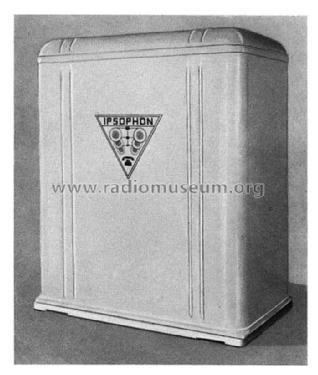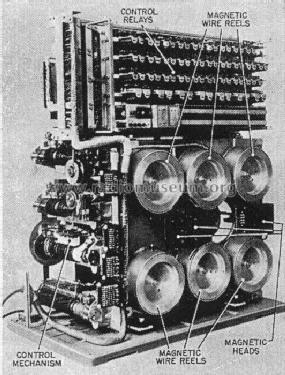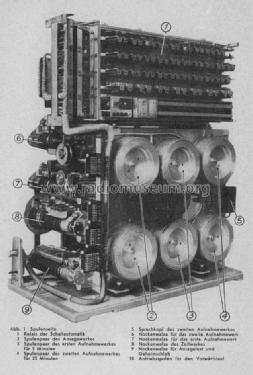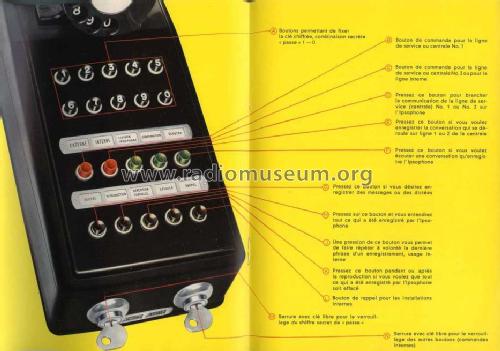Ipsophon / Ipsophone
Ipsophon-Vertriebs A.G. (siehe auch Willy Müller); Zürich
- Pays
- Suisse
- Fabricant / Marque
- Ipsophon-Vertriebs A.G. (siehe auch Willy Müller); Zürich
- Année
- 1946 ?
- Catégorie
- Téléphonie, filaire et mobile
- Radiomuseum.org ID
- 164295
- Principe général
- Amplification audio
- Gammes d'ondes
- - sans
- Particularités
- Magnétophone à fil
- Tension / type courant
- Secteur (type non connu)
- Haut-parleur
- - Pour casque ou amplificateur BF
- Matière
- Boitier métallique
- De Radiomuseum.org
- Modèle: Ipsophon / Ipsophone - Ipsophon-Vertriebs A.G. siehe
- Forme
- Console de forme générique
- Dimensions (LHP)
- 710 x 820 x 420 mm / 28 x 32.3 x 16.5 inch
- Remarques
-
Ipsophone (auch Ipsophon) Anrufbeantworter, bestehend aus Kontrollgerät mit Telefonhörer und dem Recorder. Drei Drahtton-Spulen, davon eine Ansage- und zwei Aufnahme-Spulen (5 und 25 Minuten). Codierte Fernabfrage (drei Ziffern, akustisch relaisgesteuert).
Entwicklung in den 1940er Jahre von Willy Müller (siehe Willy Müller & Co. KG), zunächst in München, dann in der Schweiz. Durch Oerlikon zur Serienreife entwickelt, verkauft durch die Ipsophon-Vertriebs GmbH Zürich.
Siehe auch Notaphon / Notaphone mit ähnlichem Funktionsumfang, aber Aufzeichung bis zu 30 min auf Magnetton-Platten.
- Poids net
- 164 kg / 361 lb 3.7 oz (361.233 lb)
- Littérature
- Begun: Magnetic Recording, 5.Auflage1954, S.155
- Auteur
- Modèle crée par Georg Richter. Voir les propositions de modification pour les contributeurs supplémentaires.
- D'autres Modèles
-
Vous pourrez trouver sous ce lien 1 modèles d'appareils, 1 avec des images et 0 avec des schémas.
Tous les appareils de Ipsophon-Vertriebs A.G. (siehe auch Willy Müller); Zürich
Musées
Le modèle Ipsophon / Ipsophone peut être vu dans les musées suivants.
Contributions du forum pour ce modèle: Ipsophon-Vertriebs A: Ipsophon / Ipsophone
Discussions: 2 | Publications: 3
Bericht aus Funk-Technik Nr.13/1948 S.319:
In der FUNK-TECHNIK Nr. 9/1948 S.215 veröffentlichten wir einen Beitrag über das in der Schweiz konstruierte Notaphon. Die Schweizer Werkzeugmaschinenfabrik Oerlikon hat ebenfalls eine Kombination von Fernsprechgerät und Magnetofon herausgebracht.
Das Ipsofon besteht aus einem Tischapparat und einem Schaltschrank, der eine Reihe von Relais und drei Magnetofonbänder mit den dazugehörigen Aufnahme-, Abhör- und Löscheinrichtungen beherbergt. Ein Band enthält die Ansage für den anrufenden Teilnehmer, der zur Durchgabe seiner Mitteilung aufgefordert wird. Die beiden anderen Bänder dienen zur Aufnahme des Gespräches; damit das Gespräch sofort nach Beendigung der Aufnahme abgehört werden kann, wird zunächst ein Band mit einer Laufzeit von fünf Minuten besprochen, das während der Besprechung des zweiten Bandes, das eine Kapazität von 25 Minuten hat, zurückgespult wird. Während des Abhörens des ersten Bandes wird das zweite Band mit fünffacher Geschwindigkeit zurückgerollt.
Die Besonderheit des Ipsofons besteht aber darin, daß die aufgezeichneten Gespräche nicht nur am Gerät selbst, sondern auch durch Anruf des Ipsofon-Teilnehmers von außerhalb abgehört werden können. Auf dem Tischapparat befindet sich eine Anzahl numerierter Tasten, durch deren Eindrücken vom Ipsofon-Inhaber eine beliebige Kennummer eingestellt werden kann. Die eingestellte Nummer ist an dem Apparat nicht erkenntlich und daher nur dem Inhaber und dessen Vertrauensleuten bekannt. Nach Anruf der Ipsofon-Sprechstelle spricht diese langsam mehrmals die Zahlenreihe Null bis Neun vor und der Anrufende muß jeweils nach der Zahl, die der Kennziffer entspricht, einen Sprechimpuls geben. Ist auf diese Weise die dreistellige Kennziffer richtig durchgegeben worden, beginnt die Wiedergabe des aufgezeichneten Gespräches. Nach Beendigung der Wiedergabe kann das Ipsofon weitere Mitteilungen des Anruf enden aufnehmen oder auf das Kommando „Löschen" alle vorhandenen Aufzeichnungen tilgen.
Das Ipsofon kann an alle Selbstwählernetze angeschlossen werden und ist auch als Diktiermaschine zu verwenden, die von beliebigen Haus- oder Fernanschlüssen abgehört werden kann.
Georg Richter, 25.Sep.18
Semi J. Begun wrote in his book "Magnetic Recording" (5th edition, 1954):
The Ipsophone, developed by the research division of the Oerlikon Machine-Tool Works of Bührle and Company near Zurich, Switzerland, is a magnetic-recording device that automatically records and reproduces telephone messages. Although magnetic recording is almost ideally adapted to such service, and although telephone recorders have been manufactured in Europe for many years, the Ipsophone is the first device in which the many technical problems involved seem to have been solved to satisfaction.
The Ipsophone consists of two parts, a telephone handset mounted on a control box and a much larger housing containing the magnetic-recording apparatus, relays, amplifiers, and so on. Three complete magnetic-recording channels are included in the apparatus, one of which is used to answer the telephone when the subscriber is not present, and which provides a series of signals needed for remote control of the equipment. After the telephone rings a few times, a recorded message informs the caller that an Ipsophone is ready to record. The other two channels are provided for recording incoming messages. The recording mechanism can be seen in Fig. 6—27.
 Fig. 6-27
Fig. 6-27
Of the two recording channels, one records for 5 min. and the other for 25 min. The purpose of this dual-channel recording arrangement is to reduce to a very short time the waiting period necessary during rewind. The rewind-record ratio for both units is 5 to 1, and with both reels empty, the 5 min. reel is recorded first, after which all subsequent recordings are made on the second reel. As soon as the first reel is fully recorded, it rewinds automatically, ready to repeat immediately. When the repeat signal is given to the machine, the second reel rewinds while the first is playing. The maximum possible waiting time necessary for rewinding is thus only 1 min. The magnetic-recording apparatus, which employs steel wire for the recording medium, is straightforward. Of particular interest is the ingenious system of voice-operated relays that makes it possible for an Ipsophone subscriber to have his telephone messages repeated to him by telephone, without at the same time giving access to unauthorized persons. After the Ipsophone has announced that it is ready to accept a message, the calling party can by using a code word make the instrument start counting. The Ipsophone slowly repeats "one, two, three, .... .... .... ten." The subscriber pronounces the words, "Hello, Hello," after three of these numbers, upon which the Ipsophone will repeat all recorded messages into the telephone. The subscriber can set the apparatus to respond to any three numbers he wishes, and the possible number of combinations is high enough so that secrecy is well assured.
Unfortunately there is no picture of the telephone handset control box available, so any extending informations would be highly appreciated.
GR
Georg Richter, 12.Nov.09









